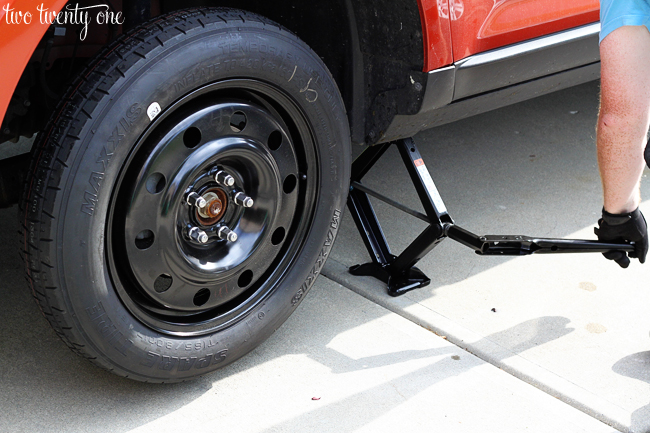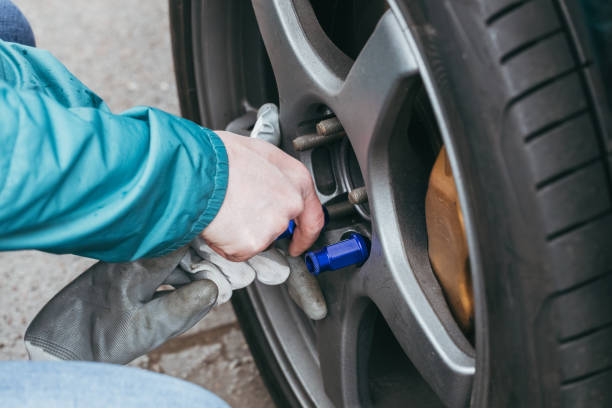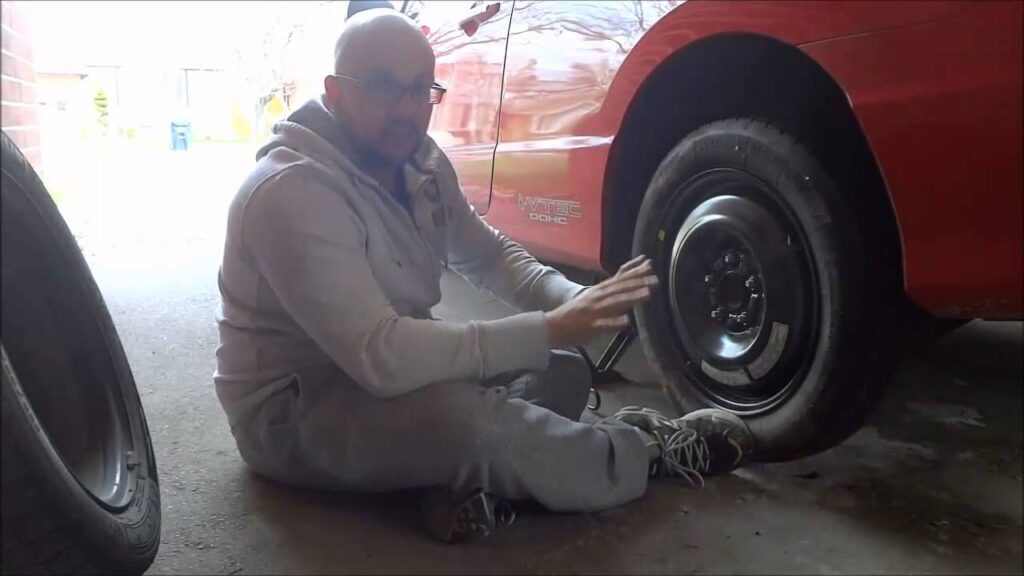To put a spare tire, loosen the lug nuts, jack up the car, remove the flat tire, and install the spare. Tighten the lug nuts securely.
Changing a flat tire is a crucial skill for any driver. It ensures you can safely continue your journey without waiting for roadside assistance. Keeping a spare tire in good condition is essential. Regularly check its air pressure and make sure all necessary tools are in your vehicle.
These tools typically include a jack, a lug wrench, and the spare tire itself. Knowing the correct procedure will save you time and stress. Practice makes perfect, so familiarize yourself with the process. This knowledge can be a real lifesaver in an emergency situation.

Introduction To Spare Tires
Having a spare tire is essential for any driver. It provides peace of mind on the road. Unexpected flat tires can happen anytime. Knowing how to use your spare tire is crucial.
The Importance Of Being Prepared
Being prepared for a flat tire can save you time and stress. Flat tires can occur without warning. A spare tire ensures you can continue your journey. It keeps you from being stranded in dangerous places.
Carrying a spare tire shows responsibility. It helps you handle emergencies confidently. Every driver should know how to use their spare tire.
Types Of Spare Tires
There are different types of spare tires. Each has its specific use and limitations. Understanding these types helps you choose the right one.
| Type | Description |
|---|---|
| Full-Size Spare | A full-size spare matches your regular tire. It can be used long-term. |
| Temporary/Compact Spare | A smaller, lightweight tire. It’s meant for short distances and lower speeds. |
| Run-Flat Tire | These tires can be driven on even when flat. They eliminate the need for an immediate replacement. |
Each type has its pros and cons. Choose based on your needs and driving habits.
Full-size spares offer full functionality. Compact spares save space but have limitations. Run-flat tires provide convenience but may cost more.
Preparation Before The Need Arises
Changing a tire can be stressful. Preparation is essential to handle this situation smoothly. Before any emergency, ensure you are ready. This guide will help you understand the steps to take for a tire change.
Tools Required For Tire Change
Having the right tools is crucial. Below is a list of tools you need:
- Spare Tire – Make sure it is in good condition.
- Jack – A strong jack to lift your car.
- Lug Wrench – Useful for loosening and tightening lug nuts.
- Wheel Wedges – To prevent your car from rolling.
- Gloves – Keep your hands clean and protected.
- Flashlight – Helpful in low-light conditions.
Regular Maintenance Checks
Regular checks can save you from future problems. Here are some checks to perform:
- Inspect Your Spare Tire – Ensure it is properly inflated.
- Check Tire Treads – Look for signs of wear and tear.
- Test Your Jack – Make sure it works smoothly.
- Verify Lug Wrench Fits – Ensure it matches your car’s lug nuts.
- Examine Wheel Wedges – Check for any damage.
Maintaining these tools and checks can give you peace of mind. Always be prepared to handle a tire change without stress. Keep this guide handy and stay safe on the road.
Locating Your Spare Tire And Tools
Knowing where your spare tire and tools are can save you time. It’s essential to locate them before an emergency arises. This section will guide you through the basics of finding these crucial items in your vehicle.
Spare Tire Storage Basics
The spare tire is often stored in specific spots in different cars. Typically, you can find it in the trunk, under the vehicle, or attached to the rear. Check your car’s manual for the exact location.
For trunk storage, lift the trunk floor cover. The spare tire is usually under a panel or a mat. For under vehicle storage, look for a latch or a winch. You may need to use tools to lower the tire.
In SUVs or trucks, the spare tire might be mounted on the rear door. Inspect the rear part of your vehicle to confirm this.
Tool Kit Accessibility
Your tool kit is equally important. It often includes a jack, lug wrench, and other necessary tools. These tools are usually stored near the spare tire.
If the spare is in the trunk, the tool kit might be in a compartment close by. Look for small compartments or boxes around the spare tire area.
For vehicles with the spare tire under the car, the tool kit is often under the seats or in a side compartment. SUVs and trucks with rear-mounted spares often have the tool kit in the cargo area.
| Vehicle Type | Spare Tire Location | Tool Kit Location |
|---|---|---|
| Sedan | Trunk | Near Spare Tire |
| SUV | Rear Door | Cargo Area |
| Truck | Under Vehicle | Under Seats |
Removing The Flat Tire Safely
Removing a flat tire safely is crucial to avoid injuries. Here, we will guide you through the steps to ensure your safety. Follow these simple guidelines to replace your flat tire efficiently.
Vehicle Positioning
Park your vehicle on a flat, stable surface. Turn on your hazard lights. Ensure your car is in park (for automatic) or in gear (for manual). Engage the parking brake. Place wheel chocks behind the wheels to prevent rolling.
Wheel Lug Nut Loosening
Use a lug wrench to loosen the lug nuts. Turn the nuts counterclockwise to loosen them. Do not remove them completely yet. Loosen each lug nut by a half turn.
Mounting The Spare Tire
Mounting a spare tire is essential for every driver. This guide helps you learn the steps to mount a spare tire correctly. Follow these steps to get back on the road quickly.
Lifting The Car
First, find a flat and safe location to lift the car. Place the jack under the car’s frame near the flat tire. Ensure the jack is in the correct position to avoid damage.
Next, use the jack to lift the car slowly. Ensure the car is steady before you proceed. Lift the car until the flat tire is off the ground.
Securing The Spare
Remove the flat tire by loosening the lug nuts. Keep the nuts in a safe place. Align the spare tire with the wheel bolts.
Place the spare tire on the wheel hub. Hand-tighten the lug nuts to hold the tire in place. Use a lug wrench to tighten the nuts in a star pattern.
Lower the car slowly using the jack. Once the car is on the ground, tighten the lug nuts again to ensure they are secure.
| Step | Description |
|---|---|
| 1 | Find a safe location |
| 2 | Position the jack |
| 3 | Lift the car |
| 4 | Remove the flat tire |
| 5 | Mount the spare tire |
| 6 | Tighten the lug nuts |
| 7 | Lower the car |
| 8 | Re-tighten the lug nuts |

Post-installation Checklist
After installing the spare tire, it’s crucial to follow a post-installation checklist. This ensures your safety and the proper functioning of your vehicle. Below are the key steps to follow:
Tightening Lug Nuts
Begin by tightening the lug nuts in a star pattern. This helps distribute the pressure evenly. Use a lug wrench to tighten each nut as much as you can.
Important: Tighten the lug nuts in a star or crisscross pattern. Avoid tightening in a circular sequence. This ensures that the wheel is properly seated.
- Start with one lug nut and move to the opposite one.
- Repeat until all lug nuts are tight.
- Ensure each nut is securely tightened.
Lowering The Car Properly
Next, lower the car slowly and carefully. Use the jack to bring the car down until the tire touches the ground.
- Place the jack handle in the jack.
- Turn the handle slowly to lower the car.
- Ensure the car is stable and the tire is flat on the ground.
After the car is fully lowered, remove the jack. Double-check the tightness of the lug nuts once more.
| Step | Action |
|---|---|
| 1 | Tighten lug nuts in a star pattern |
| 2 | Lower the car slowly with the jack |
| 3 | Double-check lug nuts tightness |
Following this post-installation checklist ensures your spare tire is securely installed. This minimizes risks and keeps you safe on the road.

Frequently Asked Questions
What Is The Correct Way To Put On A Spare Tire?
To put on a spare tire, first loosen the lug nuts. Jack up the car, remove the flat tire, and place the spare. Tighten the lug nuts by hand, lower the car, and then fully tighten the lug nuts with a wrench.
Check tire pressure.
Is It Hard To Put A Spare Tire On?
No, it’s not hard to put on a spare tire. Follow the car’s manual and safety guidelines.
How To Put A Spare Wheel On?
To put on a spare wheel, first, loosen the lug nuts. Then, jack up the car. Remove the flat tire. Mount the spare wheel onto the hub. Tighten the lug nuts by hand. Lower the car and fully tighten the lug nuts using a wrench.
Where Is The Safest Place To Put A Spare Tire?
The safest place to put a spare tire is in your car’s trunk or undercarriage compartment. These spots protect the tire from weather and theft.
How Do I Locate The Spare Tire?
Check your vehicle’s trunk or underneath the rear for a mounted spare tire.
Conclusion
Changing a spare tire is a valuable skill. It ensures you’re prepared for unexpected roadside emergencies. Follow the steps outlined to stay safe and efficient. Regularly check your spare tire’s condition. With practice, you’ll gain confidence and be ready for any tire-related issues on the road.





















